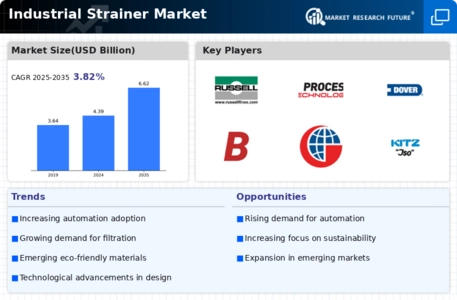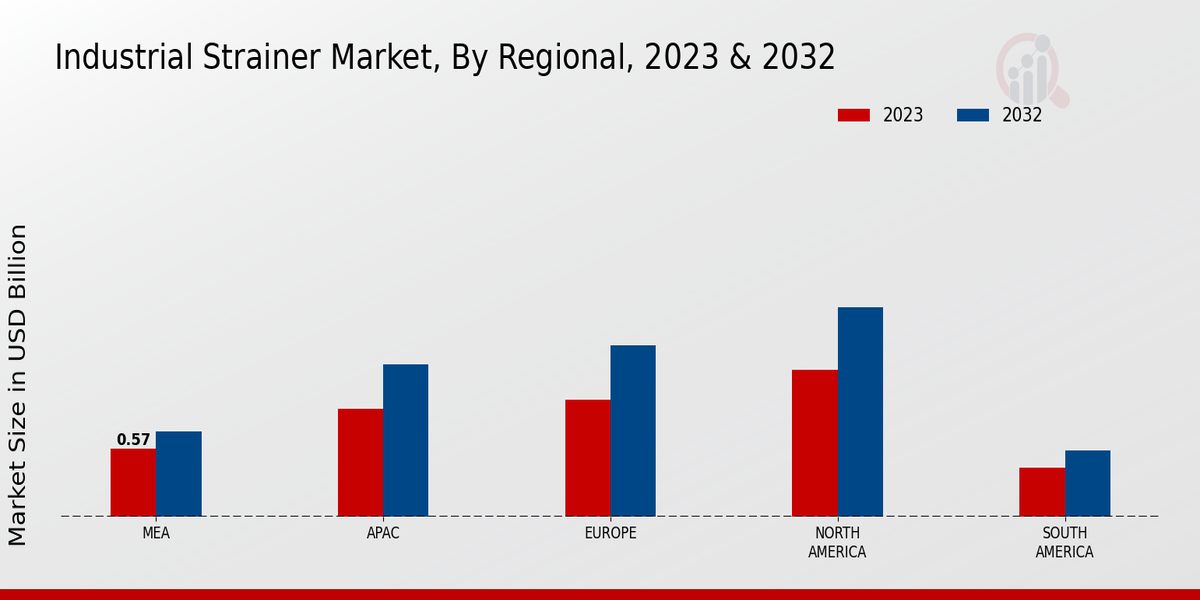Market Growth Projections
The Global Industrial Strainer Market Industry is poised for substantial growth, with projections indicating a market value of 4.39 USD Billion in 2024 and an anticipated increase to 6.62 USD Billion by 2035. This growth reflects a compound annual growth rate of 3.81% from 2025 to 2035, driven by various factors such as technological advancements, regulatory compliance, and rising industrialization in emerging economies. The market's expansion is indicative of the increasing reliance on efficient filtration systems across multiple sectors, including oil and gas, water treatment, and manufacturing. As industries continue to prioritize operational efficiency and sustainability, the demand for industrial strainers is expected to rise.
Expansion of Oil and Gas Sector
The expansion of the oil and gas sector plays a pivotal role in the Global Industrial Strainer Market Industry. As exploration and production activities increase, the demand for reliable filtration systems becomes critical to ensure the integrity of pipelines and equipment. Strainers are essential in removing debris and particulates from crude oil and natural gas, thereby preventing costly downtime and equipment failures. This sector's growth is expected to drive the market, with projections indicating a rise to 6.62 USD Billion by 2035. The ongoing investments in infrastructure and technology within the oil and gas industry further highlight the necessity for advanced straining solutions.
Growing Demand for Water Treatment Solutions
The Global Industrial Strainer Market Industry is experiencing a surge in demand for water treatment solutions, driven by increasing concerns over water quality and environmental regulations. Industries such as municipal water treatment and wastewater management are adopting strainers to ensure the removal of contaminants and particulates. This trend is likely to contribute to the market's growth, as the industry is projected to reach 4.39 USD Billion in 2024. The need for efficient filtration systems in various sectors, including food and beverage, pharmaceuticals, and chemicals, further underscores the importance of strainers in maintaining operational efficiency and compliance with stringent regulations.
Rising Industrialization in Emerging Economies
Rising industrialization in emerging economies is a key driver for the Global Industrial Strainer Market Industry. Countries in Asia-Pacific, Latin America, and Africa are witnessing rapid industrial growth, leading to increased demand for efficient filtration systems across various sectors. As industries expand, the need for reliable straining solutions becomes paramount to ensure operational efficiency and product quality. This trend is expected to contribute to the market's growth trajectory, with projections indicating a significant increase in demand for industrial strainers. The ongoing investments in infrastructure development in these regions further highlight the potential for market expansion.
Technological Advancements in Filtration Systems
Technological advancements in filtration systems are significantly influencing the Global Industrial Strainer Market Industry. Innovations such as automated strainers and smart monitoring systems enhance operational efficiency and reduce maintenance costs. These advancements allow industries to optimize their filtration processes, leading to improved product quality and reduced waste. As industries increasingly adopt these technologies, the market is likely to witness a compound annual growth rate of 3.81% from 2025 to 2035. The integration of IoT and AI in strainer systems is expected to further revolutionize the market, providing real-time data and analytics for better decision-making.
Regulatory Compliance and Environmental Standards
Regulatory compliance and environmental standards are driving the Global Industrial Strainer Market Industry as industries strive to meet stringent guidelines. Governments worldwide are implementing regulations that mandate the use of effective filtration systems to minimize environmental impact. Strainers are crucial in ensuring that industrial processes do not discharge harmful substances into the environment. This regulatory landscape is likely to propel market growth, as companies invest in advanced straining solutions to avoid penalties and enhance their sustainability efforts. The increasing focus on corporate social responsibility further emphasizes the importance of compliance in driving demand for industrial strainers.








